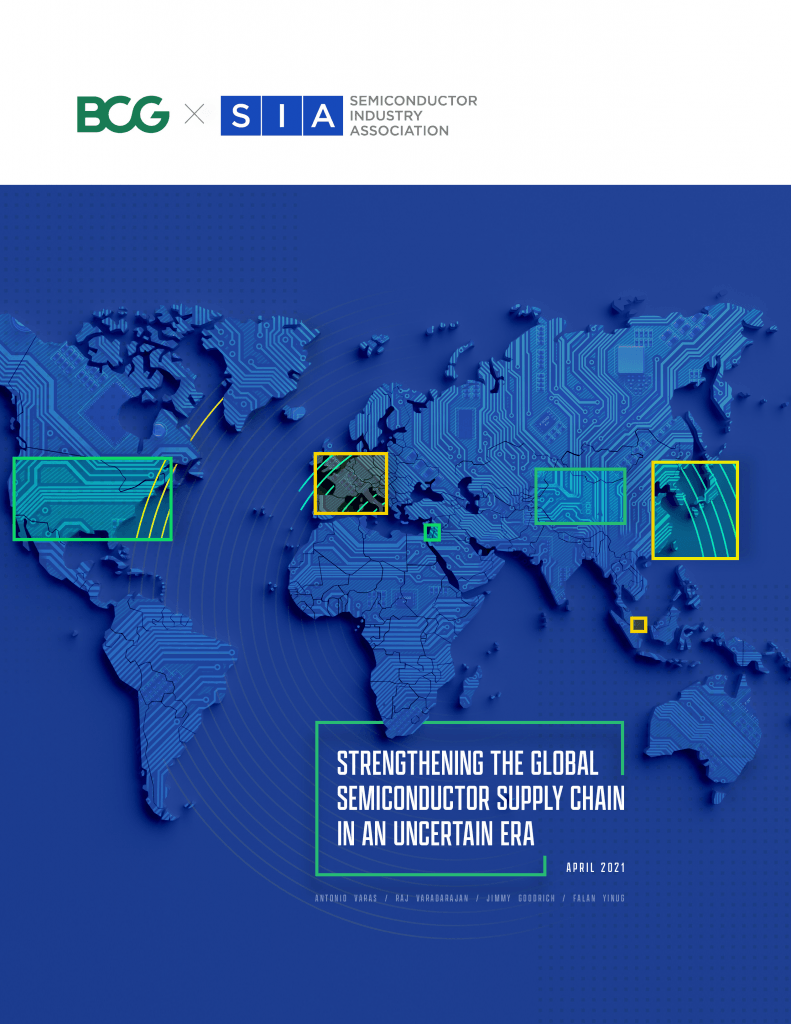Study Identifies Benefits and Vulnerabilities of Global Semiconductor Supply Chain, Recommends Government Actions to Strengthen It
Thursday, Apr 01, 2021, 5:00am
by Semiconductor Industry Association
While geographic specialization has promoted innovation and kept costs low for consumers, it has also created supply chain risks that should be addressed through government incentives to boost domestic chip production, according to Boston Consulting Group/SIA study

WASHINGTON—April 1, 2021—The Semiconductor Industry Association (SIA), in partnership with the Boston Consulting Group (BCG), today released a study analyzing the benefits and vulnerabilities of the global semiconductor supply chain and recommending government actions to ensure its long-term strength and resilience. The report, titled “Strengthening the Global Semiconductor Supply Chain in an Uncertain Era,” finds that while the current global semiconductor supply chain structure based on geographic specialization has enabled tremendous innovation, productivity, and cost savings over the last 30 years, new supply chain vulnerabilities have emerged that must be addressed by government actions, including funding incentives to boost domestic chip production and research.
“Semiconductors have enabled the greatest period of technological advancement in human history, and they will be absolutely essential to the innovations that will power America’s economy, national security, and critical infrastructure for years to come,” said Bob Bruggeworth, President, CEO, and Director of Qorvo and SIA Board Chair. “U.S. government investments in domestic semiconductor manufacturing and research will help address vulnerabilities in the supply chain and ensure more of the essential chips our country needs are produced domestically.”
Key report findings:
1. The highly specialized global semiconductor supply chain has supported the industry’s continuous technology innovation, benefitted consumers, and delivered enormous value. A hypothetical alternative with fully self-sufficient local supply chains in each region would require at least $1 trillion in incremental upfront investment and result in a 35% to 65% overall increase in semiconductor prices, ultimately resulting in higher costs of electronic devices for consumers.
2. Geographic specialization has created vulnerabilities in the global semiconductor supply chain. There are more than 50 points across the value chain where one region holds more than 65% of the global market share. These are potential single points of failure that could be disrupted by natural disasters, infrastructure shutdowns, or international conflicts, and may cause severe interruptions in the supply of essential chips. About 75% of global semiconductor manufacturing capacity, for example, is concentrated in China and East Asia, a region significantly exposed to high seismic activity and geopolitical tensions. In addition, 100% of the world’s most advanced (below 10 nanometers) semiconductor manufacturing capacity is currently located in Taiwan (92%) and South Korea (8%). These advanced chips are essential to America’s economy, national security, and critical infrastructure. An extreme hypothetical scenario of complete disruption of Taiwanese foundries for one year could cause the global electronics supply chain to come to a halt, creating significant global economic disruptions. If such hypothetical complete disruption were to be become permanent, it could take a minimum of three years and a $350 billion investment to build enough capacity in the rest of the world to replace the Taiwanese foundries.
3. Government action is needed to address vulnerabilities in the global semiconductor supply chain and ensure its long-term strength and resilience. To reduce the risk of major global supply disruptions, the U.S. government should enact market-driven incentive programs to achieve a more diversified geographic footprint. These incentives should aim to expand semiconductor manufacturing capacity in the U.S. and broaden the supply of some critical materials. For example, the additional capacity from such incentives would enable the U.S. to meet domestic demand for advanced logic chips used in defense, aerospace, and critical infrastructure.
The report also calls for the following government actions to promote long-term supply chain resilience:
- Guarantee a level global playing field for domestic and foreign firms alike, as well as strong protection of intellectual property rights;
- Promote global trade and international collaboration on R&D and technology standards;
- Invest in basic research, STEM education, and workforce development;
- Advance immigration policies that enable leading global semiconductor clusters to attract world-class talent; and
- Establish a clear and stable framework for targeted controls on semiconductor trade that avoid broad unilateral restrictions on technologies and vendors.
“The global semiconductor shortage is a stark reminder of the risks of supply chain disruptions and the need for the U.S. government to take swift action to invest in domestic chip manufacturing and research,” said John Neuffer, SIA president and CEO. “We look forward to working with leaders in Congress and the administration to promote U.S. semiconductor production and innovation so America stays on top in this foundational technology.”
# # #
Media Contact
Dan Rosso
Semiconductor Industry Association
240-305-4738
drosso@semiconductors.org
About SIA
The Semiconductor Industry Association (SIA) is the voice of the semiconductor industry, one of America’s top export industries and a key driver of America’s economic strength, national security, and global competitiveness. Semiconductors – the tiny chips that enable modern technologies – power incredible products and services that have transformed our lives and our economy. The semiconductor industry directly employs nearly a quarter of a million workers in the United States, and U.S. semiconductor company sales totaled $208 billion in 2020. SIA represents 98 percent of the U.S. semiconductor industry by revenue and nearly two-thirds of non-U.S. chip firms. Through this coalition, SIA seeks to strengthen leadership of semiconductor manufacturing, design, and research by working with Congress, the Administration, and key industry stakeholders around the world to encourage policies that fuel innovation, propel business, and drive international competition. Learn more at www.semiconductors.org.
